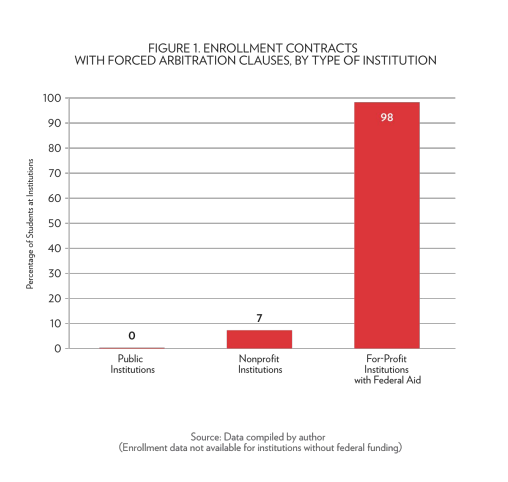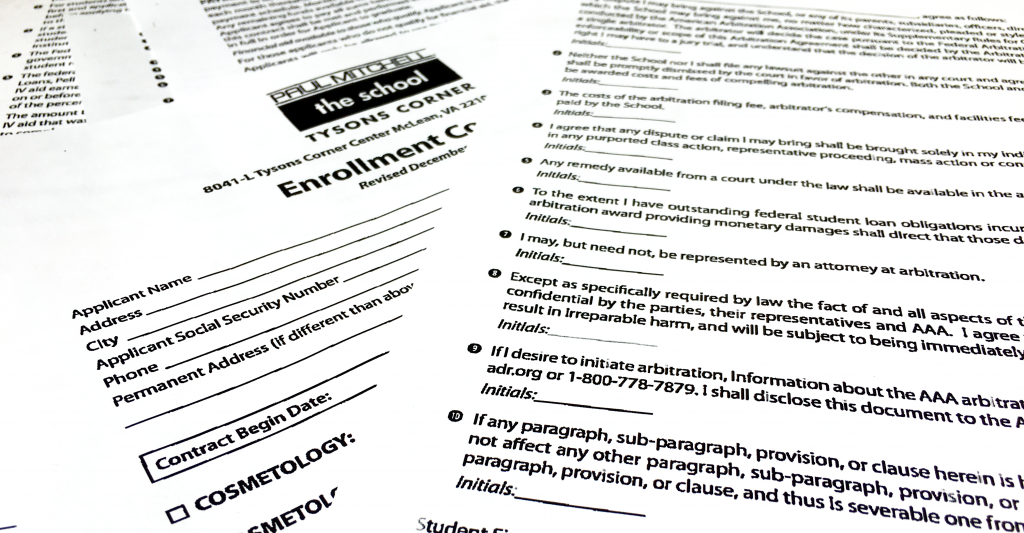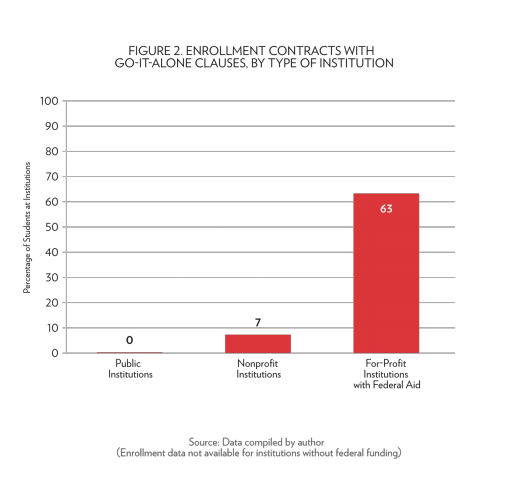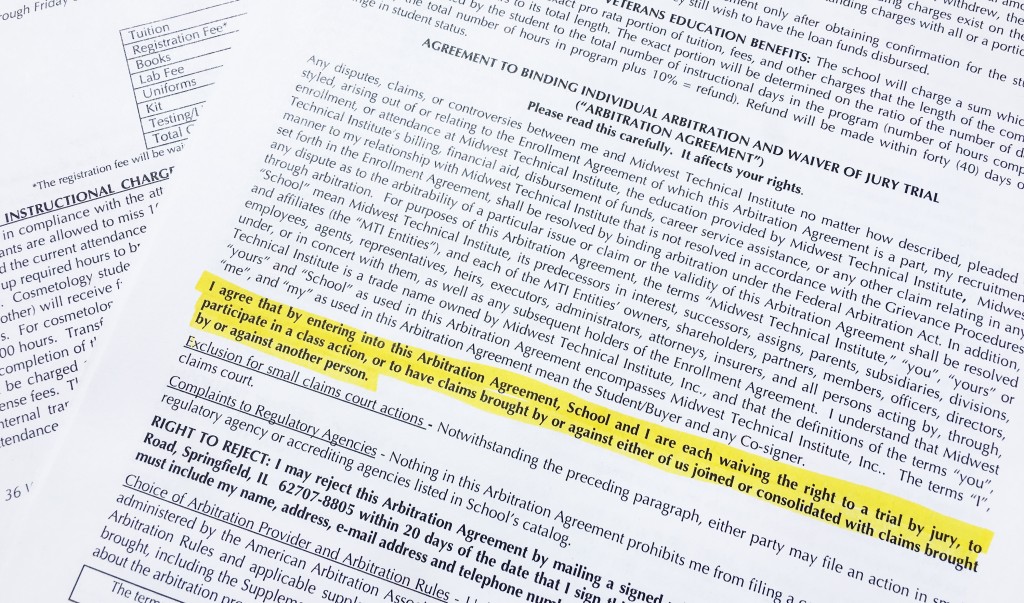When students go to college, they are confronted with a flurry of paperwork—applications, financial aid forms, housing forms, and so on—all of which seems pretty routine. Increasingly, however, some schools have been including an additional form hidden in that stack of innocuous documents that is quite unlike the others: an enrollment contract.
Not generally found in traditional higher education, these enrollment contracts—formal, legalistic agreements—include language that spells out the options each signee has in a range of situations, ones that probably appear purely hypothetical to most enrollees. One can forgive students—intent on a journey that they hope will change their lives in wonderful ways—for signing everything put in front of them, as quickly as they would click “agree” to the terms and conditions of an online app. The language in these enrollment contracts, however, has a very specific purpose: protecting the financial interests of the school by limiting a student’s legal rights, should something go wrong.
This report examines the use of enrollment contracts by various colleges—specifically, those provisions that restrict the ways in which students and former students can seek any redress of grievances against these institutions, should they feel the need. It presents the results of a survey of postsecondary institutions, illustrating the basic types of restrictive provisions most frequently employed, the specific language typically used, the various agreements in which these restrictive provisions appear, and the sorts of schools that often have such contractual agreements. The report concludes with recommendations to address this insidious practice, followed by a table listing the data for each institution studied.
Students Feeling Cheated, Trapped
Stories stemming from colleges’ use of enrollment contracts have appeared in the press with increasing frequency. These accounts follow a pretty familiar script, in which an idealistic student in the role of David confronts a corporate Goliath of a school, but in most cases, Goliath wins.
Jacob, for example, invested his time, money, and energy in a college he was led to believe would lead him to a career in the technology industry. Instead, according to investigative journalist Molly Hensley-Clancy, he ended up without the skills or the job—but with significant debt. When he and other disillusioned classmates tried to band together to hold the school—a for-profit company called UEI College in Long Beach, California—accountable, they discovered that among the enrollment paperwork they signed was a provision prohibiting them from going to court. Instead:
The mandatory arbitration agreement meant they were legally compelled to take their complaints to an arbitrator—a lawyer who was chosen and paid by UEI. There would be no chance for depositions before the hearing, no discovery process that might allow their lawyers to uncover wrongdoing, and essentially no way to appeal the arbitrator’s ruling.1
Under such a grievance process, there can be little doubt which way the arbitrator would rule.
In another case, Debbie Brenner and other former students at Lamson College, in Peoria, Illinois, thought that they had a slam-dunk case that the school had swindled them. They went to court, but the judge threw the case out because the enrollment contract the students signed when they initially enrolled included a “forced arbitration” clause, according to the New York Times. In arbitration, the former students found themselves making their case before a corporate lawyer who seemed intent not only on defending the school, but also for-profit education in general. In a ruling that is difficult to appeal—because of the way forced arbitration clauses are usually written—the arbitrator ruled against the former students and, to top it off, socked them with a legal bill of more than $350,000 because of the “hardship” the students had supposedly inflicted on the company that owned the school.2
While the stories of students like Jacob, Debbie, and others are increasingly making their way into the public eye, little is known about the enrollment contracts and restrictive clauses themselves. Who uses them? What do they say?
A Survey of Enrollment Contracts with Restrictive Clauses
To determine which colleges use enrollment contracts, and the types of restrictive clauses students may be subject to, we sought to collect information about the contracts, if any, that students sign when they enroll at various types of postsecondary institutions throughout the country. We used a variety of methods to collect enrollment contracts from 271 schools across the higher education spectrum—public, private nonprofit, and for-profit schools—and studied them for language that limited students’ rights, should they have any complaints about the value or practices of the educational experience for which they were paying. (See the Appendix on Methodology at the end of this report.)
What we found was that while there were many different ways these schools snuck restrictive clauses into their enrollment paperwork, the types of restrictions imposed upon incoming students fell into four basic categories:
- Forced arbitration clauses. These provisions prohibit students or former students from going to court to seek resolution of any complaints, such as a student seeking a refund for an inadequate education. Instead, the college requires students to take any complaints to an arbitrator in a private, binding process.
- Go-it-alone clauses. When these provisions are included in enrollment contracts, students and former students who have complaints are not allowed to join with peers who may have similar complaints against the school (such as through a group or class action). Instead, the contractual provision requires each student to seek resolution alone.
- Gag clauses. These provisions prohibit students or former students from telling other people about the complaint-resolution process, or about the specifics of any final ruling. These types of agreements have long been common in settlements of disputes, but they are now appearing in contracts and other documents that colleges require students to sign as a condition of enrollment, before a dispute even arises.
- Internal process requirements. While all colleges encourage students to make use of internal grievance procedures, these provisions prohibit students from taking their complaints to other forums for resolution without first going through the school’s internal process.
We also found that, while these types of restrictions were frequently imposed by for-profit colleges participating in the federal financial aid program, they were used only rarely at traditional nonprofit colleges or at for-profit colleges not using federal funds, and almost never at public institutions. Table 1 shows the ten largest schools from our sample using at least one restrictive clause— all are for-profit colleges, receiving nearly $8 billion from the U.S. Department of Education in 2013—14.
| Table 1. Of Schools Studied, Ten Largest Using Restrictive Clauses | ||
| Institution | System Population | Revenue from Federal Financial Aid |
| University of Phoenix | 254,810 | $2,735,958,658.00 |
| Grand Canyon University | 62,304 | $699,257,348.00 |
| Kaplan University | 57,943 | $786,238,777.00 |
| Devry University | 56,805 | $658,646,753.00 |
| ITT Technical Institute | 44,922 | $797,069,431.00 |
| The Art Institute | 39,253 | $791,149,179.00 |
| Argosy University | 34,284 | $568,617,909.00 |
| Chamberlain College of Nursing | 23,218 | $219,157,413.00 |
| South University | 21,803 | $319,354,192.00 |
| Full Sail University | 19,285 | $317,295,961.00 |
| Source: Office of Federal Student Aid, U.S. Department of Education https://studentaid.ed.gov/sa/about/data-center/school/proprietary. | ||
Forced Arbitration Clauses
Arbitration was originally intended as a way that two parties could resolve a dispute without the cost and delays that can be involved in going to court. Different from mediation, an arbitrator has significant legal authority, and can limit essential aspects of a trial, including discovery and presentation of evidence. Once an award is decided, appealing the finding can be extremely difficult. Arbitration can be a reasonable approach when two parties, such as two companies negotiating a contract, know what they are getting into and what the possible disputes may involve. Arbitration is forced or mandatory when it is agreed to before any dispute exists and when it is part of a standard contract presented to one party on a take-it-or-leave-it basis, such as in a consumer contract or employment contract.
The use of forced arbitration has grown in recent years, becoming a strategy used by businesses to prevent consumers from going to court to hold the company in question accountable for their wrongdoing. Forced arbitration clauses are increasingly included in the fine print of contracts that consumers sign. When disputes do occur, the business usually has a significant advantage over the consumer because arbitrators rely on the company’s repeat business, while individual consumers are unlikely to use an arbitrator more than once. Because of this conflict of interest and other restrictions on consumers’ rights in arbitration, forced arbitration clauses have become a shield that invites abuse by businesses, rather than the efficient dispute-resolution process that was originally intended.3
Because of this conflict of interest and other restrictions on consumers’ rights in arbitration, forced arbitration clauses have become a shield that invites abuse by businesses, rather than the efficient dispute-resolution process that was originally intended.
Our survey found that forced arbitration clauses are far from ubiquitous in higher education. (See Figure 1.) Indeed, we did not find even one public university that requires students to commit to arbitration as a condition of enrolling, and only one nonprofit college out of thirty-four. At for-profit colleges, the use of forced arbitration depends primarily on whether the school is receiving federal money. Among those that are, most students are required to sign away their right to go to court.

A majority of the for-profit schools using federal aid in our sample (93 of 158 institutions) include forced arbitration clauses in their contracts, but those schools enroll a much larger proportion of students from the sample of federally funded for-profit schools (98 percent).4 Of the forty-nine for-profit schools not using federal aid, only one school used a forced arbitration clause. Below are three examples of how forced arbitration clauses appear in the enrollment contracts that students are asked to sign. For Kaplan University, the clause is a single sentence in the signature block, on the second page within the enrollment contract. South University includes multiple paragraphs, including a fully capitalized paragraph within the twelve-page contract it requires students to sign. In its ten-page contract, Paul Mitchell the School, which trains cosmetologists, has a full page on arbitration, requiring students to initial each of ten separate statements.
|
“Any controversy or claim arising out of, or relating to, this agreement, or breach thereof, no matter how pleaded or styled, shall be settled by arbitration in accordance with the Commercial Rules of the American Arbitration Association, and judgment upon the award rendered by the arbitrator(s) may be entered in any court having jurisdiction.”
Source: Kaplan University, Enrollment Contract Signature Block. View full contract. |
|
“If either a student or South University chooses arbitration, neither party will have the right to a jury trial, to engage in discovery, except as provided in the applicable arbitration rules, or otherwise to litigate the dispute or claim in any court (other than in small claims or similar court, as set forth in the preceding paragraph, or in an action to enforce the arbitrator’s award). Further, a student will not have the right to participate as a representative or member of any class of claimants pertaining to any claim subject to arbitration. The arbitrator’s decision will be final and binding. Other rights that a student or South University would have in court also may not be available in arbitration.”
Source: South University, Enrollment Contract. View full contract. |

While arbitration clauses—if a school uses them—usually appear in an enrollment contract, there are some schools that make reference to other documents the student is agreeing to, such as a school catalog. We identified five cases in which the arbitration clauses were not included in the enrollment contract, but instead included in the school catalog (which was referenced as binding in the enrollment contract).
Go-It-Alone Clauses
When individuals have complaints about the practices of a single company or individual, they frequently have the choice of bringing their disputes themselves, consolidating jointly in a single case, or filing representative suits or “class actions.” Group approaches are common in consumer cases because individual consumers often do not have the knowledge or financial resources to pursue a claim. By joining forces, consumers are able to gain the legal representation and evidence they need to make their case. Go-it-alone clauses within enrollment contracts prevent students and former students from being able to seek resolution of their complaints by teaming up with others. Since students or former students who must pursue their complaints individually are much less likely to do so, prohibiting group action enables worse behavior by schools.
The patterns we found in the use of go-it-alone clauses are similar to forced arbitration. Public and nonprofit colleges and privately funded for-profit colleges almost never prohibit group action by their students and former students, while more than a fifth of the for-profit colleges using federal aid in the survey required students to seek redress of grievances only in individual proceedings, representing 63 percent of the student enrollment in the federally funded for-profit sample. (See Figure 2.) It is important to note that, due to recent Supreme Court decisions, it is likely that even colleges without a go-it-alone clause in the enrollment contract would argue that the arbitration clause itself prohibits class actions.5 So the presence of an express ban on class action does not sufficiently capture the schools where students will be unable to arbitrate their claims as a class.

Although go-it-alone clauses appear in our data less frequently than forced arbitration clauses, this may in part be due to our method of data collection. Specifically, Illinois includes a provision in its communications with vocational schools that discourages the use of these clauses, potentially suppressing the usage rate of go-it-alone clauses among for-profit schools receiving federal aid. Still, the percentage of students enrolled within these schools (63 percent) far exceeds the percentage of institutions using such clauses (22 percent) in our sample.
Go-it-alone clauses are usually included within an arbitration clause. As shown below, Midwest Technical Institute includes a section within its enrollment contract specifying that any complainant cannot be part of a class action, or bring claims consolidated with other individuals. Cortiva Institute simply states that any issue will be resolved through individual, binding arbitration, a clarification that, as discussed above, may be redundant.

Gag Clauses
Gag clauses prohibit students and former students from sharing information about their complaint—or about the complaint-resolution process—with anyone. While confidentiality agreements are frequently included in settlements to disputes, requiring consumers to keep their complaints secret seems to be a new strategy by companies to prevent tales of the disputes themselves from reaching the media or law enforcement agencies. Like requiring individual rather than group processes, the strategy also inserts a firewall between wronged students, reducing the likelihood that they will learn about each other’s complaints, preventing them from working together to seek a better resolution.
We found gag clauses in about one in every ten enrollment contracts at for-profit colleges receiving federal aid. No such provisions were found at nonprofit, public, or privately funded for-profit institutions.
We found gag clauses in about one in every ten enrollment contracts at for-profit colleges receiving federal aid. No such provisions were found at nonprofit, public, or privately funded for-profit institutions. In the example below, from Coyne College, students must agree to keep confidential “all aspects” of their dispute. A student who considers making the dispute public could be stopped by the school, pointing to the fact that the student agreed that any violation of the gag clause would cause “irreparable harm.”
|
Except as specifically required by the laws of the State of Illinois, the fact of and all aspects of this arbitration and the underlying dispute shall remain strictly confidential by the parties, their representatives. I agree that any actual or threatened violation of this provision would result in irreparable harm, and will be subject to being immediately enjoined.
Source: Coyne College, Arbitration Agreement. View full contract. |
Internal Process Requirement
All schools have internal dispute processes to help students with issues, and it is good practice to invite and encourage students and former students to use those internal procedures as a first course of action. Some schools, however, are attempting to prohibit their students and former students from ever taking their complaints elsewhere, even if internal mechanisms offer no relief, essentially trapping them at an institution that they may not trust. Our research found sixteen institutions, all for-profits receiving federal aid, included language in their contracts which mandates students to go through the institution’s internal grievance process prior to taking their complaints to arbitration.
One way that a school could attempt to enforce this requirement is to argue that relief through arbitration is not available if the student pursues a different route first. In the case of ITT Technical Institute, which has caught the attention of law enforcement agencies for allegedly misleading prospective students,6 the school scolded former students for taking their complaints to the U.S. Department of Veterans Affairs rather than using the agreed-to grievance procedures. In a letter responding to a student’s complaint, ITT said it was responding “even though this is outside of our established Student Complaint/Grievance Procedure,” implying that the student had violated a contractual obligation.
“A copy of your complaint sent to the Veterans’ Administration (VA) has been forwarded to my attention. I appreciate the opportunity to respond to the concern(s) you submitted online at http://www.benefits.va.gov/gibill.
Please note that when you enrolled at ITT Technical Institute, you signed an Enrollment Agreement (EA) in which you agreed to all terms of our school catalog, including our published Student Complaint/Grievance Procedure. A review of our records reveals that you did not use our established Student Complaint/Grievance Procedure to first afford the school you attended the opportunity to address or respond to your concerns. ITT Educational Services, Inc. is providing a response to your concerns even though this is outside of our established Student Complaint/Grievance Procedure. You can, however, locate the ITT Technical Institute you attended by accessing our website at http://www.itt-tech.edu/campus/ and then view the school’s catalog and Student Complaint/Grievance Procedure by selecting the “Catalog” hyperlink underneath the “Campus Information” section of the applicable campus webpage.”
While steering complaints away from law enforcement is not as common as arbitration clauses, the approach is finding its way into official government policy. In an interstate pact for regulating online colleges across state lines, there is a provision prohibiting state oversight agencies from following up on complaints about a college unless the complaints have gone “through the institution’s own procedures for resolution of grievances,” and only after the student has “appealed” the school’s action.7 The provision dramatically impedes state agencies’ ability to follow up on or even accept complaints, and creates misleading data about the incidence of problems at an institution. The compact, which was developed jointly by traditional and for-profit colleges, has been signed by thirty-six states.8
The Unusual Cases: A Nonprofit and a Stock-Trading School
The one established nonprofit institution in the sample that uses restrictive clauses is National University, which reports an enrollment of about 18,000 students, a majority of them attending part time. The school has an open admissions policy, and enrolls students online and at dozens of satellite locations, mostly in California.9
The one privately funded for-profit institution that we found using restrictive clauses is a school that trains people to trade stocks online. The school came to our attention in a unique way. As we were conducting our research, an employee of The Century Foundation discovered that a close relative—recently retired and with time on his hands—had attended a free introductory training session at a school called the Online Trading Academy, which promised to teach students how to make money through online trading of stocks, bonds and foreign currencies. The retiree—we will call him Ralph—had signed up for the initial classes after seeing an infomercial that billed the school as the “world’s most trusted name in professional trader education,” and the training as perfect for “protect[ing] your retirement dollars.”10
At the training session, the presenter claimed the full course had a success rate of 97 percent, and he talked about graduates who had doubled their investment portfolios. As the students were counseled individually at the end of the free introductory session, Ralph signed up for the full course of twelve in-person training sessions at a cost of $17,500. According to Ralph, the school representative suggested he keep his wife in the dark about the course if he was truly serious about making a lot of money.
Shortly after signing the contract for the course, Ralph mentioned his new endeavor to his relative at The Century Foundation, who reviewed the contract materials and encouraged Ralph to reconsider his decision to enroll. When Ralph sought to cancel the contract, the Online Trading Academy required him to return the contract and other materials before releasing him from his commitment. Snapshots taken of the enrollment contract show that it included a forced arbitration clause and an agreement that “any dispute resolution proceedings will be conducted on an individual basis.” The tuition charge would have been subject to an interest rate of 17.9 percent if it was not paid promptly.
The design of the Online Trading Academy is similar in many ways to the investor training offered by Trump University. One difference, though, is that students who enrolled at Trump University did not sign contracts waiving their rights to join with other customers and to go to court. As a result, the details of how Trump University operated are now a matter of public record, and the students will get their day in court.11
The Use and Evolution of Enrollment Contracts
To conduct our research on restrictive provisions that colleges impose on students, we needed to collect copies of the contracts that students sign when they enroll at a college. Very quickly our research hit a snag. If we could find an enrollment contract used by an institution, then we could, from that document, make a determination about the use of the four types of restrictive provisions. The problem was that at most traditional nonprofit and public institutions, college representatives had no idea what we meant when we asked for their “enrollment contract” or their “enrollment agreement.” While all of the for-profit institutions in our sample used enrollment contracts, none of the public institutions did. (Ten of the thirty-four nonprofit institutions use enrollment contracts, but that likely overstates their frequency because those schools were identified by searching for enrollment contracts online.)
We conferred with national associations representing public and nonprofit colleges and they confirmed that most traditional colleges in fact do not use enrollment contracts. Further, we asked colleges without enrollment contracts about the kinds of commitments that students do make when they enroll. Traditional universities do have plenty of rules and procedures, usually described at length in the college catalog or a student handbook. Among the most common are honor codes that speak to issues of academic integrity and to how students treat each other. But other than deposits holding their seat in a class, and dormitory agreements, the only other enrollment-related agreement we could find is the form students use to apply for an early, binding admissions decision.12
Why are enrollment contracts common at for-profit colleges? The original impetus seems to have been consumer protection. We found a number of states that require private postsecondary schools to provide students with a contract that indicates the name and duration of the educational program the student is signing up for, the costs, and the refund policy. Several states include an additional disclosure informing the student that the program does not guarantee employment. Some include a cancellation process for students who change their mind, such as Texas (three days) and California (seven days). The Illinois contract prohibits students from being charged for, or being required to commit to, more than one term at a time. In addition, most or all of the agencies that accredit, primarily, for-profit institutions (the “national” accreditors) require colleges to use enrollment contracts, with consumer protection as the purported rationale.
We found no state or accreditor that requires contract provisions that restrict students’ rights. Yet notwithstanding its consumer-protection origins, the enrollment contract has become, for some schools, a convenient place to insert legalistic small print that reduces the chances that a school’s wrongdoing will be remedied. The four types of restrictive clauses we detail in this report are not the only provisions we found. National University, for example, the one established nonprofit that uses restrictive clauses, requires enrolling students to “specifically represent and warrant that . . . you have not been promised anything other than what is contained in this agreement or in the Catalog.” If a National University student were to complain that an advertisement or a recruiter’s assertions were misleading, the school would no doubt point to this clause, signed by the student, essentially agreeing to disregard anything the advertisements and recruiters said leading up to the signing of the contract.
By adding a sentence or two, an enrollment contract intended as a consumer protection instead becomes a license for dishonest or predatory behavior.
By adding a sentence or two, an enrollment contract intended as a consumer protection instead becomes a license for dishonest or predatory behavior.
Recommendations
Restrictive clauses are not in the best interests of students enrolling in college. Instead, they represent attempts by colleges to create room for unscrupulous marketing and lower-quality education. Colleges that are using restrictive clauses should remove them from their enrollment contracts. At the same time, agencies that oversee colleges can take action to protect consumers:
- The U.S. Department of Education should prohibit the use of pre-dispute arbitration requirements and class action bans in enrolling students in institutions that receive federal aid. The U.S. Department of Education has the authority to take action and should do so without delay.13
- Accrediting agencies should consider restrictive clauses in enrollment contracts to be indicators that an institution lacks the integrity to qualify as an accredited institution.
- State agencies that collect schools’ enrollment contracts should make those contracts publicly available electronically so that they can be used by law enforcement to identify potentially predatory schools, and to can be analyzed by consumer protection experts.
When students choose a college, they have every reason to believe that the college is on their side, leading them to academic success and a bright future. A college that takes advantage of students at that optimistic moment, requiring them to sign away their rights, does not deserve taxpayer support.
Appendix: Methodology
The findings in this report are based on data from 271 institutions, collected through a variety of methods. The largest source of enrollment contracts came from freedom-of-information requests filed with state agencies that review enrollment contracts in their oversight of private institutions. In response to the requests, agencies in six states—Illinois, Virginia, Arizona, California, Texas, and Florida—provided documents from a total of 171 private postsecondary institutions.14 In addition, we created a random sample of public and private nonprofit institutions and attempted to survey them by phone and email, asking questions regarding the steps students take to enroll, yielding information from twenty-four institutions (as discussed below, most traditional colleges do not use formal enrollment contracts). Online searches for enrollment contracts and related material yielded documents from an additional thirty institutions, and copies of enrollment contracts from eleven large for-profit institutions were available through a U.S. Senate report.15 Information about thirty-five institutions came through personal contacts with school representatives or students.16
Of the 271 total institutions in the sample, 207 are for-profit, thirty are public institutions and thirty-four are long-time nonprofit institutions. (Three institutions that recently converted to nonprofit are categorized in this report as for-profit, since that is where their business processes developed).17 The high yield of for-profit institutions is due in large part to the fact that some for-profit schools are subject to state disclosure regulations, thus making it possible to collect enrollment contracts in bulk. Public and nonprofit institutions, meanwhile, do not usually use enrollment contracts at all, making it difficult to confirm the lack of a restrictive clause since there is no standard document to inspect. As a result of the variety of methods that were used to assemble the sample, the survey is not likely a precise representation of the full universe of institutions.
All of the public and nonprofit institutions surveyed receive federal financial aid from the U.S. Department of Education. Of the for-profit institutions in the sample, 158 receive federal financial aid, while forty-nine do not. In an attempt to better represent the proportion of students likely exposed to restrictive clauses, for colleges using federal aid, we calculated the number of students enrolled by school system, and present percentages of student populations exposed to restrictive clauses. Enrollment data were not available for schools not receiving federal aid.18
Complete collection of enrollment documents
Notes
- Molly Hensley-Clancy, “Students Ripped Off By For-Profit Colleges Discover They Can’t Sue,” Buzzfeed, March 29, 2016, http://www.buzzfeed.com/mollyhensleyclancy/students-ripped-off-by-for-profit-schools-cant-sue#.jiOPYX1J0.
- Jessica Silver-Greenberg and Michael Corkery, “In Arbitration, a ‘Privatization of the Justice System,’” New York Times, November 1, 2015, http://www.nytimes.com/2015/11/02/business/dealbook/in-arbitration-a-privatization-of-the-justice-system.html?_r=0.
- For more background on forced arbitration, see Consumer Financial Protection Bureau, “Arbitration Study: Report to Congress, pursuant to Dodd–Frank Wall Street Reform and Consumer Protection Act § 1028(a),” March 2015, http://files.consumerfinance.gov/f/201503_cfpb_arbitration-study-report-to-congress-2015.pdf.
- The proportion of students enrolled calculates the total number of students enrolled in each school system: if multiple locations of an institution appeared in our sample, we only counted that institution once.
- See the Supreme Court’s decisions in Stolt-Nielsen S.A. v. AnimalFeeds Int’l Corp., 559 U.S. 662 (2010), and Oxford Health Plans, 133 S. Ct. 2064.
- “ITT Tech Sued for Deceiving Students about Its Computer Network Systems Program and Success in Finding Jobs,” Massachusetts Attorney General, http://www.mass.gov/ago/news-and-updates/press-releases/2016/2016-04-04-itt-tech.html.
- State Authorization Reciprocity Agreement, Policies and Standards, Section 4(2)(a) and Section 7, dated February 17, 2016, http://nc-sara.org/files/docs/NC-SARA_Policies_Standards.pdf.
- Margaret Mattes, “Bad Deal on Online Education Would Leave New Yorkers Unprotected,” The Century Foundation, March 16, 2016, https://tcf.org/content/commentary/bad-deal-on-online-education-would-leave-new-yorkers-unprotected/.
- College Navigator, National Center for Education Statistics, U.S. Department of Education; National University website, http://www.nu.edu/Locations.html. While a 2013 enrollment contract from National included forced arbitration, a contract dated 2011 did not.
- A clip from the infomercial is available at http://www.scripttoscreen.com/vimeo-video/online-trading-academy-drtv-long-form-show/.
- United States Court of Appeals, Ninth Circuit, Makaeff v. Trump, April 17, 2013, http://caselaw.findlaw.com/us-9th-circuit/1628150.html.
- Students applying for early decision are committing to enroll in a particular college if they are admitted, and are allowed to make such a commitment to only one college. In applying early decision, the student along with the parent and a counselor must sign a standard form that is part of the Common Application. See the “Early Decision Agreement” contract at http://admissions.duke.edu/images/uploads/process/ED_agreement.pdf.
- Public Citizen, “Citizen Petition,” February 24, 2016, http://www.citizen.org/documents/Citizen-Petition-to-ED-Title-IV-Arbitration-Clauses.pdf.
- These were the states that responded to our document requests in time for inclusion in the survey.
- United States Senate Health, Education, Labor, and Pension Committee, “For Profit Higher Education: The Failure to Safeguard the Federal Investment and Ensure Student Success,” July 30, 2012, http://www.help.senate.gov/imo/media/for_profit_report/Contents.pdf.
- We asked states for the most recent, approved contracts from state agencies. However, some agencies reported difficulty in supplying the most recent contracts. Therefore, some contracts collected may be older versions.
- Everest University, Herzing University, and CollegeAmerica all recently converted to nonprofit tax status, two were discussed in The Covert For-Profit; see Robert Shireman, “The Covert For-Profit,” The Century Foundation, September 22, 2015, https://tcf.org/content/report/covert-for-profit/.
- Integrated Postsecondary Education Data System, National Center for Education Statistics, U.S. Department of Education.











